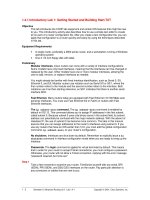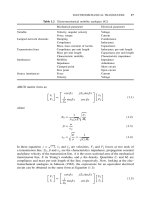Tài liệu Artificial Intelligence and Soft Computing P1 pdf
Bạn đang xem bản rút gọn của tài liệu. Xem và tải ngay bản đầy đủ của tài liệu tại đây (704.27 KB, 30 trang )
CAT#1385 Half-Title Page 11/29/01 9:42 AM Page 1
Behavioral and Cognitive Modeling
of the Human Brain
Artificial Intelligence
and
Soft Computing
CAT#1385 Title Page 11/29/01 9:43 AM Page 1
Behavioral and Cognitive Modeling
of the Human Brain
Amit Konar
Department of Electronics and Tele-communication Engineering
Jadavpur University, Calcutta, India
Artificial Intelligence
and
Soft Computing
Boca Raton London New York Washington, D.C.
CRC Press
This book contains information obtained from authentic and highly regarded sources. Reprinted material
is quoted with permission, and sources are indicated. A wide variety of references are listed. Reasonable
efforts have been made to publish reliable data and information, but the author and the publisher cannot
assume responsibility for the validity of all materials or for the consequences of their use.
Neither this book nor any part may be reproduced or transmitted in any form or by any means, electronic
or mechanical, including photocopying, microfilming, and recording, or by any information storage or
retrieval system, without prior permission in writing from the publisher.
The consent of CRC Press LLC does not extend to copying for general distribution, for promotion, for
creating new works, or for resale. Specific permission must be obtained in writing from CRC Press LLC
for such copying.
Direct all inquiries to CRC Press LLC, 2000 N.W. Corporate Blvd., Boca Raton, Florida 33431.
Trademark Notice:
Product or corporate names may be trademarks or registered trademarks, and are
used only for identification and explanation, without intent to infringe.
© 2000 by CRC Press LLC
No claim to original U.S. Government works
International Standard Book Number 0-8493-1385
Library of Congress Card Number 99-048018
Printed in the United States of America 2 3 4 5 6 7 8 9 0
Printed on acid-free paper
Library of Congress Cataloging-in-Publication Data
Konar, Amit.
Artificial intelligence and soft computing : behavioral and cognitive modeling of
the human brain / Amit Konar.
p. cm.
Includes bibliographical references and index.
ISBN 0-8493-1385-6 (alk. paper)
1. Soft computing. 2. Artificial intelligence. 3. Brain—Computer simulation. I. Title.
QA76.9.S63 K59 1999
006.3--dc21 99-048018
CIP
PREFACE
The book, to the best of the author’s knowledge, is the first text of its kind that
presents both the traditional and the modern aspects of ‘AI and Soft
Computing’ in a clear, insightful and highly comprehensive writing style. It
provides an in-depth analysis of the mathematical models and algorithms, and
demonstrates their applications in real world problems of significant
complexity.
1. About the book
The book covers 24 chapters altogether. It starts with the behavioral
perspective of the ‘human cognition’ and covers in detail the tools and
techniques required for its intelligent realization on machines. The classical
chapters on search, symbolic logic, planning and machine learning have been
covered in sufficient details, including the latest research in the subject. The
modern aspects of soft computing have been introduced from the first
principles and discussed in a semi-informal manner, so that a beginner of the
subject is able to grasp it with minimal effort. Besides soft computing, the
other leading aspects of current AI research covered in the book include non-
monotonic and spatio-temporal reasoning, knowledge acquisition,
verification, validation and maintenance issues, realization of cognition on
machines and the architecture of AI machines. The book ends with two case
studies: one on ‘criminal investigation’ and the other on ‘navigational
planning of robots,’ where the main emphasis is given on the realization of
intelligent systems using the methodologies covered in the book.
The book is unique for its diversity in contents, clarity and precision of
presentation and the overall completeness of its chapters. It requires no
mathematical prerequisites beyond the high school algebra and elementary
differential calculus; however, a mathematical maturity is required to follow
the logical concepts presented therein. An elementary background of data
structure and a high level programming language like Pascal or C is helpful to
understand the book. The book, thus, though meant for two semester courses
of computer science, will be equally useful to readers of other engineering
disciplines and psychology as well as for its diverse contents, clear
presentation and minimum prerequisite requirements.
In order to make the students aware of the applied side of the subject,
the book includes a few homework problems, selected from a wide range of
topics. The problems supplied, in general, are of three types: i) numerical, ii)
reflexive and iii) provocative. The numerical problems test the students’
understanding of the subject. The reflexive type requires a formulation of the
problem from its statement before finding its solution. The provocative type
includes the well-known problems of modern AI research, the solution to
some of which are known, and some are open ended. With adequate hints
supplied with the problems, the students will be able to solve most of the
numerical and reflexive type problems themselves. The provocative type,
however, requires some guidance from the teacher in charge. The last type of
problems is included in the text to give the research-oriented readers an idea
of the current trend in AI research. Graduate students of AI will also find
these problems useful for their dissertation work.
The book includes a large number of computer simulations to illustrate
the concepts presented in logic programming, fuzzy Petri nets, imaging and
robotics. Most of the simulation programs are coded in C and Pascal, so that
students without any background of PROLOG and LISP may understand them
easily. These programs will enhance the students’ confidence in the subject
and enable them to design the simulation programs, assigned in the exercise as
homework problems. The professionals will find these simulations interesting
as it requires understanding of the end results only, rather than the formal
proofs of the theorems presented in the text.
2. Special features
The book includes the following special features.
i) Unified theme of presentation: Most of the existing texts on AI cover a set
of chapters of diverse thoughts, without demonstrating their inter-relationship.
The readers, therefore, are misled with the belief that AI is merely a
collection of intelligent algorithms, which precisely is not correct. The
proposed book is developed from the perspective of cognitive science, which
provides the readers with the view that the psychological model of cognition
can be visualized as a cycle of 5 mental states: sensing, acquisition,
perception, planning and action, and there exists a strong interdependence
between each two sequential states. The significance of search in the state of
perception, reasoning in the state of planning, and learning as an intermediate
process between sensing and action thus makes sense. The unified theme of
the book, therefore, is to realize the behavioral perspective of cognition on an
intelligent machine, so as to enable it act and think like a human being.
Readers will enjoy the book especially for its totality with an ultimate aim to
build intelligent machines.
ii) Comprehensive coverage of the mathematical models: This probably is
the first book that provides a comprehensive coverage of the mathematical
models on AI and Soft Computing. The existing texts on “mathematical
modeling in AI” are beyond the scope of undergraduate students.
Consequently, while taking courses at graduate level, the students face much
difficulty in studying from monographs and journals. The book, however,
bridges the potential gap between the textbooks and advanced monographs in
the subject by presenting the mathematical models from a layman’s
understanding of the problems.
iii) Case studies: This is the only book that demonstrates the realization of
the proposed tools and techniques of AI and Soft Computing through case
studies. The readers, through these case studies, will understand the
significance of the joint usage of the AI and Soft Computing tools and
techniques in interesting problems of the real world. Case studies for two
distinct problems with special emphasis to their realization have been covered
in the book in two separate chapters. The case study I is concerned with a
problem of criminal investigation, where the readers will learn to use the soft
computing tools in facial image matching, fingerprint classification, speaker
identification and incidental description based reasoning. The readers can
build up their own systems by adding new fuzzy production rules and facts
and deleting the unwanted rules and facts from the system. The book thus will
serve the readership from both the academic and the professional world.
Electronic and computer hobbyists will find the case study II on mobile robots
very exciting. The algorithms of navigational planning (in case study II),
though tested with reference to “Nomad Super Scout II robot,” have been
presented in generic form, so that the interested readers can code them for
other wheel-based mobile robots.
iv) Line Diagrams: The book includes around 190 line diagrams to give the
readers a better insight to the subject. Readers will enjoy the book for they
directly get a deeper view of the subject through diagrams with a minimal
reading of the text.
3. Origin of the book
The book is an outgrowth of the lecture materials prepared by the author for a
one semester course on “Artificial Intelligence,” offered to the graduate
students in the department of Electronics and Telecommunication
Engineering, Jadavpur University, Calcutta. An early version of the text was
also used in a summer-school on “AI and Neural Nets,” offered to the faculty
members of various engineering colleges for their academic development and
training. The training program included theories followed by a laboratory
course, where the attendees developed programs in PROLOG, Pascal and C
with the help of sample programs/toolkit. The toolkit is included in the book
on a CD and the procedure to use it is presented in Appendix A.
4. Structural organization of the book
The structural organization of the book is presented below with a dependency
graph of chapters, where Ch. 9 → Ch. 10 means that chapter 10 should be
read following chapter 9, for example.
Ch. 1
Ch.2 Ch.3 Ch.17 Ch. 13 Ch.18
Ch. 16 Ch. 19 Ch.5 Ch. 4 Ch. 23 Ch. 14
Ch. 6
Ch.7 Ch.11 Ch. 15 Ch. 20
Ch. 8
Ch. 9 Ch. 12
Ch. 10
Ch. 24 Ch. 22 Ch. 21
July 12, 1999
Jadavpur University Amit Konar
ABOUT THE AUTHOR
Amit Konar
is a Reader in the Department of Electronics and
Telecommunication Engineering, Jadavpur University, Calcutta. He received a
Ph.D. (Engineering) degree in Artificial Intelligence from the same university
in 1994 and has been teaching the subject of Artificial Intelligence to the
graduate students of his department for the last 10 years. Dr. Konar has
supervised a number of Ph.D. and M.E. theses on different aspects of machine
intelligence, including logic programming, neural networks, cognitive systems,
stochastic and fuzzy models of uncertainty, fuzzy algebra, image
understanding, architecture of intelligent machines and navigational planning
of mobile robots. He has published more than 60 papers in international
journals and conferences. He is an invited contributor of a book chapter in an
edited book published by Academic Press. Dr. Konar is a recipient of the 1997
Young Scientist Award, offered by the All India Council for Technical
Education (AICTE) for his significant contributions in Artificial Intelligence
and Soft Computing.
ACKNOWLEDGMENT
The author gratefully acknowledges the contributions of many people, who
helped him in different ways to complete the book. First and foremost, he
wishes to thank his graduate students attending the course entitled “AI and
Pattern Recognition” in ETCE department, Jadavpur University during the
1993-1999 sessions. Next, he would like to thank the scholars working for
their Ph.D. degree under his supervision. In this regard, the author
acknowledges the contribution of Ms. Jaya Sil, a recipient of the Ph.D. degree
in 1996, for spending many of her valuable hours on discussion of the
Bayesian and Markov models of knowledge representation. The other
scholars, to whom the author is greatly indebted for sharing their knowledge
in different areas of AI, are Mr. Srikant Patnaik, Mr. Biswajit Paul, Mrs. Bijita
Biswas, Ms. Sanjukta Pal, Ms. Alakananda Bhattacharya and Ms. Parbati
Saha. The contributions of Mr. Patnaik in chapter 24, Mr. Paul in chapter 14,
Ms. Biswas in chapter 23, Ms. Pal in chapter 16, Ms. Bhattacharya in chapter
22 and Ms. Saha in chapter 10 need special mention. Among his scholars, the
author wants to convey his special thanks to Mr. Patnaik, who helped him in
many ways, which simply cannot be expressed in a few sentences.
The author acknowledges the contribution of his friend Mr. Dipak Laha,
a faculty member of the Mechanical Engineering department, Jadavpur
University, who helped him in understanding the many difficult problems of
scheduling. He also would like to thank his friend Dr. Uday Kumar
Chakraborty, a faculty member of the Computer Science department,
Jadavpur University, for teaching him the fundamentals in Genetic
Algorithms. The author gives a special thanks to Ms. Sheli Murmu, his
student and now a colleague, who helped him in correcting many syntactical
errors in the draft book. He also wants to thank his graduate students
including Mr. Diptendu Bhattacharya, Ms. Bandana Barmn, and Mr.
Srikrishna Bhattacharya for their help in drawing many figures and in the
technical editing of this book. The author also wishes to thank his ex-student
Ms. Sragdhara Dutta Choudhury, who helped him draw a very simple but
beautiful sketch of the ‘classroom’ figure in chapter 6.
The architectural issues of knowledge based systems, which is the main
theme of chapter 22, is the summary of the M.E. thesis (1991-1992) of Mr.
Shirshendu Halder, who critically reviewed a large number of research papers
and interestingly presented the pros and cons of these works in his thesis.
The author owes a deep gratitude to Prof. A. K. Mandal of the
department of Electronics and Telecommunication Engineering, Jadavpur
University, for teaching him the subject of AI and providing him both
technical and moral support as a teacher, Ph.D. thesis adviser and colleague.
He is also indebted to Prof. A.K. Nath of the same department for
encouraging him to write a book and spending long hours in valuable
discussion. The author would like to thank his teacher Prof. A. B. Roy of the
department of Mathematics, Jadavpur University, who inspired his writing
skill, which later enabled him to write this book. He remembers his one-time
project supervisor Prof. T. K. Ghosal of the Department of Electrical
Engineering, Jadavpur University, for his constructive criticism, which helped
him develop a habit of checking a thought twice before deliberating. The
author also gratefully acknowledges his unaccountable debt to his teacher Mr.
Basudeb Dey, who taught him the basis to uncover the mysteries from the
statement of arithmetic problems, without which the author could never have
been able to reach his present level of maturity in mathematics.
The author wants to convey a special vote of thanks to his colleagues
Prof. S. K. Choudhury and Dr. B. Gupta for their kind gesture of attending his
classes on AI for a complete semester, which helped him to make necessary
corrections in the book.
Among his friends and well-wishers, the author would like to mention
Mr. Gourishankar Chattopadhyay, Mr. Bisweswar Jana, Mrs. Dipa Gupta,
Mr. P. K. Gupta and Prof. P.K. Sinha Roy, without whose encouragement and
inspiration the book could not have taken its present shape. His ex-students
Ms. Sanghamitra Sinha of Sun Microsystems, USA, Ms. Indrani Chakraborty
of MIE University, Japan, Mr. Ashim Biswas of HCL Technologies, NOIDA,
India and Dr. Madhumita Dasgupta of Jadavpur University, India helped him
in many ways improve the book.
The author would like to thank Ms. Nora Konopka, Acquisition Editor, and
staff members of CRC Press LLC for their kind cooperation in connection
with writing this book. He would also like to thank Prof. L. C. Jain of the
University of South Australia, Adelaide, for active cooperation and editorial
guidance on this book.
Lastly, the author wishes to express his deep gratitude to his parents, who
always stood by him throughout his life and guided him in his time of crisis.
He also wishes to thank his wife Srilekha for her tolerance of his indifference
to the family life and her assistance in many ways for the successful
completion of the book. The author is equally grateful to his in-laws and
especially his brother-in-law, Mr. Subrata Samanta, for their inspiration and
encouragement in writing this book.
September 17, 1999
Jadavpur University Amit Konar
To my parents, Mr. Sailen Konar and Mrs. Minati Konar, who
brought me up despite the stress and complexities of their lives
and devoted themselves to my education;
To my brother Sanjoy, who since his childhood shouldered
the responsibility of running our family smoothly;
To my wife Srilekha, who helped me survive and inspired me
in many ways to write and complete this book in the present
form;
To my students in various parts of the world, who through
their forbearance allowed me to improve my teaching skills;
To my teachers, who taught me the art of reacting to a
changing environment; and
To millions of the poor and down-trodden people of my
country and the world, whose sacrifice and tolerance paved
the royal road of my education,, and whose love and emotion,
smile and tears inspired me to speak their thoughts in my
words.
Amit Konar









